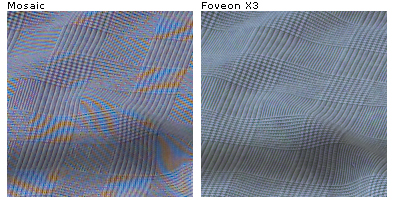Foveon digital sensor breakthrough | |||
By Ian Burley | |||
An historic announcement?Every now and again something rather historic happens and today just might prove to be one of those days. Foveon, Inc., until today, an obscure imaging technology company based in Silicon Valley, has announced a radical alternative to conventional CCD and CMOS digital imaging sensor chips used in most digital still and digital movie cameras. Dubbed ĎX3í, Foveonís new technology promises to deliver sharper colour digital pictures while reducing costs and enabling much improved hybrid still and movie cameras. Jump to: The end of the CCD?But more than that, X3 represents a potentially major change in the evolution of digital photography. If X3 substantiates its makers claims, it could end the 30 year dominance of Charge Couple Devices (CCDs) in consumer digital imaging. Itís not just hot air, either. Foveon has partnered with Japanese lens and camera maker, Sigma, to develop an X3-based prosumer digital SLR that is variously expected to sell for around US$3,000 (£2,150). The two companies have already made sample images available and they are reportedly excellent. What is X3?First, how a conventional CCD works A conventional CCD or CMOS digital image sensor is composed of an array of hundreds of thousands of light sensitive pits or photoreceptors. Each of these will represent the one pixel of a resulting image. To build a colour image, the incoming light has to be filtered. Each photoreceptor will only receive light of one primary colour. This type of filtering is known as Bayer filtering. But if one pixel only has the value for one colour, how can that make up an acceptable looking colour image? Put simply, colour values of adjacent photoreceptors are averaged or interpolated. This means colour resolution is much lower than pixel resolution of an image.
It also introduces compromises over colour accuracy and can be a contributory cause of digital imperfections, like moirť patterns and fringing How X3 worksX3 also uses colour filtering, but its cleverness enables three photoreceptors to be placed above each other, each sensitive to one of the three primary colours. So all three colours are sensed in the space of a single pixel instead of three. Colour interpolation is not necessary, simplifying the signal processing and as the image data is more pure, resulting pictures should be more vivid and sharp.
The way X3 manages its trick of sandwiching photoreceptors is through exploitation of the fact that light of different wavelengths or colours penetrates silicon to different depths. Promise of better colour and chip versatilityAs X3 sensor chips donít require complicated processing to build a final image, itís much easier to make the flexible use of the chipís sensor array. Blocks of pixels can be grouped easily to reduce resolution and increase the signal to noise ratio. This promises to make low light imaging quality a lot better and facilitate clean, high frame rate, motion video from a chip that performs without compromise as a high quality digital still imager. The bottom lineCCD technology is cheaper than it used to be, but fundamentally it remains relatively expensive and in absolute colour quality terms, a technical compromise. Canon, notably, has experimented with CMOS sensor chips in high quality cameras, like the D30 digital SLR and some of CCDís problems, like noise, have been successfully reduced. However, Canonís CMOS technology is fundamentally the same as CCD technology in that it uses Bayer filtration and so requires complex post sensor processing to create an arguably compromised image. X3 will initially promise noticeably sharper and more vivid images. Then manufacturers will start to exploit the simplicity and flexibility of the chip to create genuine high quality still and movie camera hybrids for the first time. X3 will undoubtedly command a price premium initially, but logically, it should ultimately help drive fundamental digital camera costs down faster. But is success agreed? On paper Foveonís X3 technology sounds too good to fail, but its success will only be guaranteed by the big name digital still camera and camcorder manufacturers if they embrace X3 technology at the expense of traditional CCD. Itís a well worn clichť, but only time will tell.
| |||
| |||
| Feedback | Main news page | Discussion forum | Newsletter | Home | | |||
|
DPN News service
www.dp-now.com



